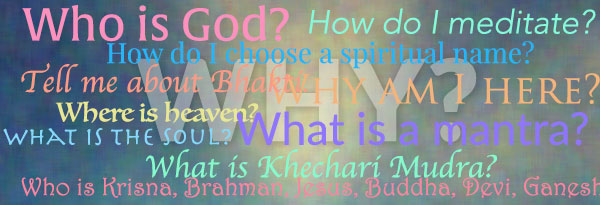
Over the years spiritual seekers have sent questions to Abbot George, from the mundane to the philosophical to the practical aspects of living a spiritual life. This recent selection of questions and answers is shorter than some, so we will share them with you in a single blog post. You can read a wide selection of these previously printed in Satsang with the Abbot: Questions and Answers About Life, Spiritual Liberty and the Pursuit of Ultimate Happiness, which is available at Amazon.com.
1. To someone who wrote about the correct attitude to adopt toward others when interacting with them, especially those with whom the yogi has a close personal relationship.
In all relationships with other human beings we are to see the divine Self in them and realize that ultimately we are relating to the Divine Itself. The moment we think someone is “ours” ego is present and problematic. That is why sadhana is so necessary to keep our minds in the correct perspective.
2. To someone who asked about Khechari Mudra.
The khechari mudra most people talk about is solely a hatha yoga method, and a foolish and dangerous one at that. Those who “fail” to do it are fortunate.
The mudras of the yogis are solely positions of the eyes. The khechari mudra of the yogis is a spontaneous turning upward of the eyes in meditation that occurs naturally when it should. To do it deliberately is to interfere with the meditation process.
In Soham sadhana this happens naturally and can come and go during a single meditation period according to how the pranas are moving spontaneously. It happens when the sushumna is activated and the process of meditation becomes centered there. Some yogic texts speak of it as occurring when the japa of Soham enters–begins to take place in–the sushumna. Then the yogi truly is a “sky walker,” which is what “khechari” means. He “flies” in the Sky of Consciousness, the Chidakasha in the Sahasrara.
3. To someone who asked if the meaning of Soham (I Am That) should be held in mind during meditation and japa.
In Soham sadhana there should be no thought of the meaning of Soham, otherwise the yogi gets caught in the realm of discursive thought (which is where most “yoga” begins and ends). It is the Soham Bhava that is desired: the literal experience of knowing “I am That.”
Soham can be translated both “I am that” and “That I am.” The second is good since Paramatma comes before the jivatman, implying that the jiva lives in Shiva. But it is awkward, so I don’t use it ordinarily. Again, Soham Bhava is what it is all about.
This all just points out the fact that Krishna was right: We must become yogis. Gorakhnath wrote: “By birth I was a Hindu, but through maturity I became a Yogi.”
4. Should God (Brahman) be called It or He?
Brahman is It, not He. And it is the same with each individual atman. “He” applies only to the relative and temporary part of our experience. The jivatman and Paramatman have no gender.
However, Ishwara is “He” in the sense that he is the Divine Positive to the Divine Negative that is Mahashakti or Prakriti (“She”).
5. Where did the words “God” and “soul” come from? Are they Christian in origin?
The English word “God” comes from a Proto-Germanic word, Gudan, which means someone who is called or invoked. It is neuter, neither masculine nor feminine.
The modern English word “soul” is derived from the Old English sawol or sawel. It is speculated that it means “coming from or belonging to the sea (or lake),” because of the Germanic and pre-Celtic belief in souls emerging from and returning to sacred lakes. It appears that in Old Saxon seola (soul) is derived from seo (sea).
In the Bible (New Testament) the Greek word Theos is translated “God” and the Greek Psuche (psyche) is translated “soul.” Theos literally means: “the absolutely Other.” In other words: Parabrahman. Psuche means the subtle, astral bodies, our psychic nature as contrasted with the Pneuma, the spirit, the unconditioned consciousness that is our true being.
6. To someone who wrote about bhakti (devotion) in spiritual life.
Shankara wrote that meditation is the true bhakti, and samadhi is true jnana. Bhakti should be translated “dedication,” though it is devotion in the sense of being devoted or dedicated to something. Sivananda continually told people: “Emotion is not Devotion.”
More Questions and Answers for Spiritual Seekers:
- Does Hell Exist, and Why?
- Kali and the Virgin Mary: Two Questions
- How to Test the Value of Psychic Experiences







